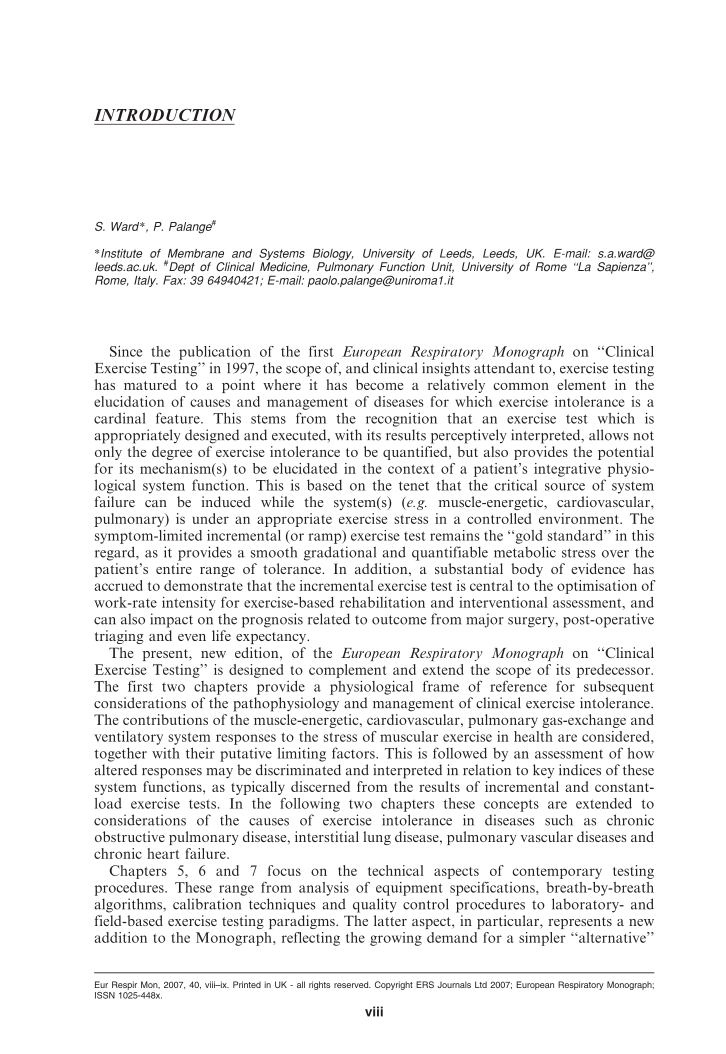INTRODUCTION S. Ward*, P. Palange# *Institute of Membrane and Systems Biology, University of Leeds, Leeds, UK. E-mail: s.a.ward@ leeds.ac.uk. # Dept of Clinical Medicine, Pulmonary Function Unit, University of Rome ‘‘La Sapienza’’, Rome, Italy. Fax: 39 64940421 E-mail: paolo.palange@uniroma1.it Since the publication of the first European Respiratory Monograph on ‘‘Clinical Exercise Testing’’ in 1997, the scope of, and clinical insights attendant to, exercise testing has matured to a point where it has become a relatively common element in the elucidation of causes and management of diseases for which exercise intolerance is a cardinal feature. This stems from the recognition that an exercise test which is appropriately designed and executed, with its results perceptively interpreted, allows not only the degree of exercise intolerance to be quantified, but also provides the potential for its mechanism(s) to be elucidated in the context of a patient’s integrative physio- logical system function. This is based on the tenet that the critical source of system failure can be induced while the system(s) (e.g. muscle-energetic, cardiovascular, pulmonary) is under an appropriate exercise stress in a controlled environment. The symptom-limited incremental (or ramp) exercise test remains the ‘‘gold standard’’ in this regard, as it provides a smooth gradational and quantifiable metabolic stress over the patient’s entire range of tolerance. In addition, a substantial body of evidence has accrued to demonstrate that the incremental exercise test is central to the optimisation of work-rate intensity for exercise-based rehabilitation and interventional assessment, and can also impact on the prognosis related to outcome from major surgery, post-operative triaging and even life expectancy. The present, new edition, of the European Respiratory Monograph on ‘‘Clinical Exercise Testing’’ is designed to complement and extend the scope of its predecessor. The first two chapters provide a physiological frame of reference for subsequent considerations of the pathophysiology and management of clinical exercise intolerance. The contributions of the muscle-energetic, cardiovascular, pulmonary gas-exchange and ventilatory system responses to the stress of muscular exercise in health are considered, together with their putative limiting factors. This is followed by an assessment of how altered responses may be discriminated and interpreted in relation to key indices of these system functions, as typically discerned from the results of incremental and constant- load exercise tests. In the following two chapters these concepts are extended to considerations of the causes of exercise intolerance in diseases such as chronic obstructive pulmonary disease, interstitial lung disease, pulmonary vascular diseases and chronic heart failure. Chapters 5, 6 and 7 focus on the technical aspects of contemporary testing procedures. These range from analysis of equipment specifications, breath-by-breath algorithms, calibration techniques and quality control procedures to laboratory- and field-based exercise testing paradigms. The latter aspect, in particular, represents a new addition to the Monograph, reflecting the growing demand for a simpler ‘‘alternative’’ Eur Respir Mon, 2007, 40, viii–ix. Printed in UK - all rights reserved. Copyright ERS Journals Ltd 2007 European Respiratory Monograph ISSN 1025-448x. viii
